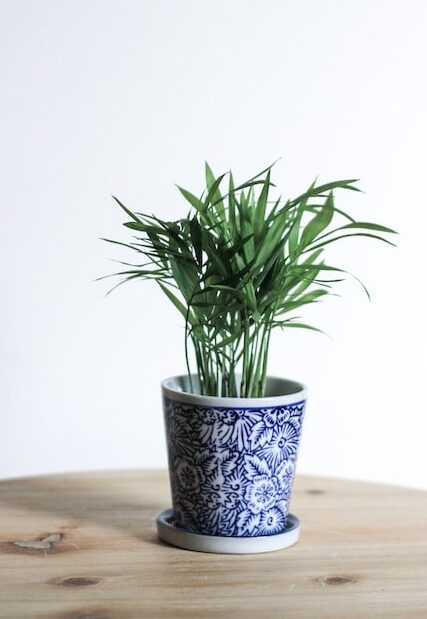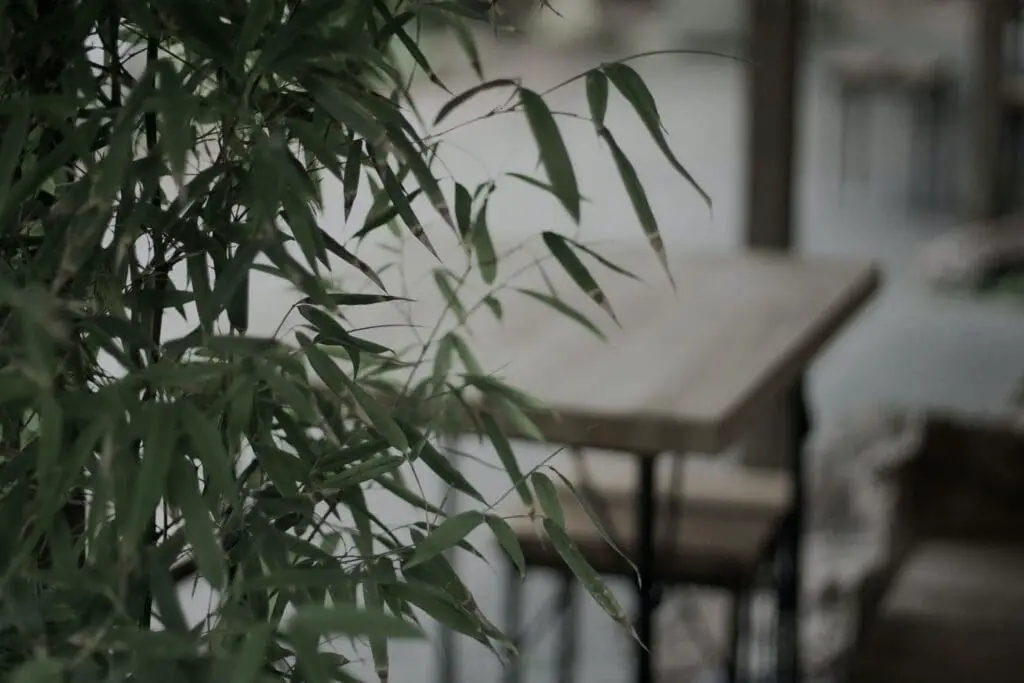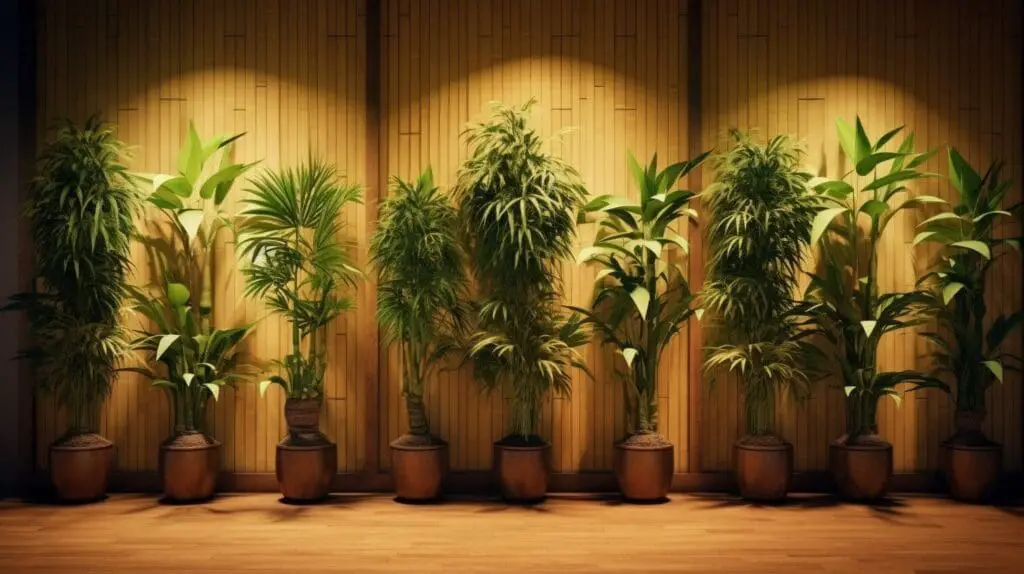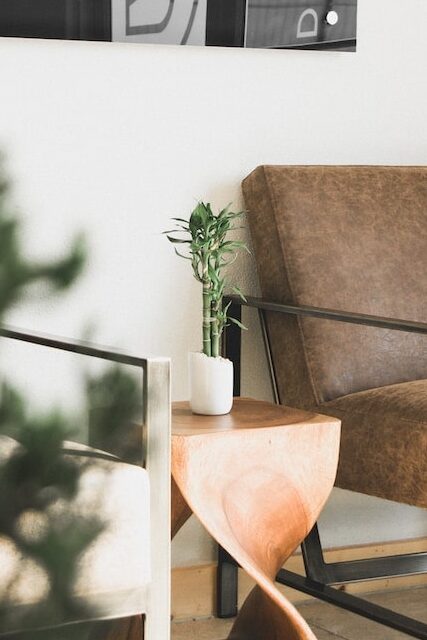Indoor Bamboo Plants: A Guide To Care And Maintenance
If you’re looking for an exotic touch to add to your home, indoor bamboo plants are a great option. However, caring for them can be quite challenging if you don’t know what you’re doing.
Luckily, with the right knowledge and care, these plants can thrive in even the most unlikely of environments.
In this guide, we’ll go over everything you need to know about taking care of indoor bamboo plants. From selecting the right variety to providing adequate light and water, we’ll cover all aspects of maintaining healthy and vibrant bamboo in your home.
Key Takeaways
- Indoor bamboo plants require high humidity and daily misting, all-day bright indirect natural light, and slow-release fertilizers supplemented with trace minerals.
- Yellowing leaves may indicate too little or too much water, insect infestation, or disease, and root-bound plants may be soaked in a large saucer of water.
- Indoor environments are usually less than ideal for bamboos, but almost any bamboo can be grown indoors with sufficient expertise and attention.
- Golden bamboo is a popular variety for indoor containers, needs at least 6 hours of light, prefers full sun to partial shade, and requires regular watering and feeding while tolerating various soil types.
Types of Bamboo
If you’re interested in growing indoor bamboo, it’s important to consider the types of bamboo available. Some species may be better suited for indoor environments and require less maintenance than others.

Three great options for indoor bamboo plants include Chusquea sulcata, dwarf whitestripe, and Bambusa multiplex ‘Tiny Fern’.
Chusquea sulcata is a clumping-type bamboo that originates from Mexico. It prefers partial sun conditions and benefits from a passing breeze. This variety can grow up to 15 feet tall indoors but can also be kept pruned to maintain a smaller size.
Dwarf whitestripe is a cultivar of running bamboo that tolerates culm trimming well and only reaches 2-3 feet in height. This variety is ideal for smaller spaces or as an accent plant. It requires regular watering and prefers bright indirect light but can tolerate some direct sunlight if acclimated gradually.
Choosing the Right Variety
When selecting a variety of bamboo for indoor cultivation, it’s important to consider factors such as size, light requirements, and maintenance needs.
There are various types of indoor bamboo plants, including clumping and running varieties. Clumping bamboos have a more compact root system and tend to be smaller in size, making them better suited for indoor growing.
Running bamboos have a more aggressive rhizome growth pattern and may require more frequent pruning.
Some recommended types of indoor bamboo include the dwarf whitestripe bamboo, which only reaches 2-3 feet in height and tolerates culm trimming well. The Bambusa multiplex ‘Tiny Fern’ is another good option; it requires at least a half day of indirect sunlight and moist soil, but accepts branch and culm pruning. Some others worth considering are:
| Species | Common Name | Description |
| Bambusa ventricosa | Buddha’s Belly Bamboo | This species has unique swollen internodes resembling the belly of Buddha. It has a compact growth habit and can thrive indoors with proper care. |
| Phyllostachys aurea | Golden Bamboo | Golden Bamboo is popular for indoor cultivation. It features beautiful golden-yellow canes and dense foliage, making it an attractive addition to any indoor space. |
| Chimonobambusa marmorea | Marble Bamboo | Marble Bamboo is a small and delicate species suitable for indoor growth. It has slender canes with striking green and white marbled patterns. |
| Pseudosasa japonica | Arrow Bamboo | Arrow Bamboo is a clumping species that can adapt well to indoor conditions. It has slender green canes and dense foliage, providing a graceful and elegant appearance. |
| Sasaella ramosa | Plume Bamboo | Plume Bamboo is a dwarf species ideal for indoor growing. It has thin canes and feathery foliage, creating a soft and delicate look. |
A popular choice is ‘lucky bamboo’. However, this is actually not a true bamboo but closely resembles it in appearance. Lucky bamboo has low maintenance needs and can create a similar atmosphere as real bamboo plants.
Growing Conditions
To ensure successful growth, it’s important to provide adequate light, water, and nutrients for your indoor bamboo plant. Here are some tips on how to grow and take care of your indoor bamboo:
- Light: Most bamboo species prefer bright indirect sunlight for at least 6 hours a day. Choose the brightest window in your house and rotate the pot weekly for even light exposure. Too much shade can result in weak plants and dull color.
- Water: Keep the soil evenly moist but not soggy. Allow the top 2-3 inches of soil to dry out before watering again. Test the soil by sticking your finger in it; if it feels dry, then it’s time to water your plant.
- Nutrients: Feed with balanced liquid fertilizer once a month during the growing season (spring to fall). Use slow-release fertilizers supplemented with trace minerals.
In addition, here are some other things you should keep in mind when taking care of indoor bamboo plants:
- Humidity: Bamboo prefers humidity levels around 50%. Use a small fountain or humidifier nearby to provide additional moisture.
- Temperature: Keep away from cold drafts and heaters. Room temperatures between 60-80 degrees Fahrenheit are ideal.
- Pruning: While not necessary, you can remove old canes if they become unsightly. Repot or divide when necessary and propagate by cutting stalks.
Remember that growing indoor bamboo plants is challenging but rewarding. With proper care and maintenance, you can enjoy this beautiful plant all year round!
Benefits of Indoor Bamboo
Did you know that having an indoor bamboo plant can benefit your home in many ways? Not only do they look beautiful, but they also improve air quality by removing harmful toxins. Additionally, indoor bamboo plants generate oxygen and have restorative powers that can help reduce stress levels.
To care for your indoor bamboo plant, it’s important to provide it with the right growing conditions. This includes placing it near a window where it can receive sufficient sunlight and humidity. Regular watering and fertilizing are also necessary to ensure healthy growth.
Overall, adding an indoor bamboo plant to your home is a great way to enhance its aesthetic appeal while reaping the many benefits it provides. With proper care and maintenance, your indoor bamboo plant will thrive and contribute positively to your living space.
Challenges of Indoor Growth
Growing bamboo indoors can be a challenging and rewarding experience, but it requires expertise and attention to overcome the unique obstacles that come with indoor growth. Here are some challenges you may face when caring for your indoor bamboo plant:
- Lack of space: Bamboo plants have fast-growing rhizome root systems that require ample space for healthy growth. In a container, they may become root-bound if not pruned and divided regularly.
- Need for moisture: Bamboo plants need consistent moisture to thrive, but over-watering can lead to root rot and other issues. It’s important to find the right balance and water carefully, allowing the soil to dry out slightly between watering sessions.
- Vulnerability to pests: Indoor plants are more inviting to insects than outdoor ones, so it’s important to keep an eye out for signs of infestation like yellowing leaves or holes in the foliage.
To care for your indoor bamboo plant:
- Provide enough space in a wide pot with good drainage.
- Water carefully, letting the soil dry out slightly before watering again.
- Monitor for pests and treat as needed using sprays or washing leaves under running water.
- Find the right balance of light exposure, humidity levels, and temperature fluctuations necessary for growth.
- Prune regularly or divide when necessary to prevent overcrowding in the container.
Root Pruning
Root pruning is an essential task for ensuring the healthy growth of indoor bamboo plants. As bamboo has a fast-growing rhizome root system, it can quickly become root-bound in containers. This can lead to stunted growth and even cause the plant to die. Therefore, regular root pruning is necessary to maintain healthy growth.
To root prune your indoor bamboo plant, gently remove it from its container and trim the roots with a sharp, clean pair of scissors or pruning shears. Cut back any circling or tangled roots and trim away any dead or damaged ones. Be careful not to cut too much as this can damage the plant.
After pruning, replant the bamboo in fresh soil in a slightly larger container than before. Make sure there are drainage holes at the bottom of the pot to prevent overwatering. Water thoroughly after replanting and continue with regular care and maintenance for your indoor bamboo plant.
By regularly performing root pruning on your indoor bamboo plants, you can ensure their health and longevity in your home environment.
Watering and Drainage
To keep your indoor bamboo thriving, you’ll need to make sure that you’re watering it properly and providing adequate drainage. Indoor bamboo plants require consistent moisture, but overwatering can lead to root rot. Water your bamboo deeply enough so the soil is moist but not waterlogged. A good rule of thumb is to allow the top 2-3 inches of soil to dry out before watering again.



When it comes to drainage, ensure that your pot has sufficient drainage holes and a layer of gravel at the bottom for better airflow. Avoid using standing water or pebble trays as they can lead to stagnant water and promote fungal growth. If your plant becomes root-bound, consider repotting it into a larger container with fresh potting mix.
As every indoor environment is different, how often you should water your indoor bamboo plant will depend on factors such as humidity levels, temperature, and light exposure. However, a general guideline is to check the soil moisture level frequently by sticking your finger about an inch deep into the soil. If it feels dry at this depth, then it’s time for watering.
By following these tips on proper watering and drainage practices for indoor bamboo care, you can help ensure that your plant thrives in its new home!
Light Requirements
Now that you know how to properly water and maintain drainage for your indoor bamboo plant, it’s important to understand its light requirements for optimal growth. Most indoor bamboo plants require bright, indirect natural light for at least 6 hours a day. However, some species can tolerate partial shade or even full sun exposure for a few hours each day.



To determine the best location for your indoor bamboo plant, consider the amount of sunlight it will receive throughout the day. A south-facing window is ideal, but if direct sunlight is too intense, consider placing your plant near an east or west-facing window instead. If you don’t have access to natural light, consider using artificial grow lights with a timer for at least 12-14 hours per day.
It’s important to rotate your indoor bamboo plant weekly so that all sides receive equal amounts of light exposure. Use a simple table as shown below to keep track of which side has been facing the light source and when it needs to be rotated.
By understanding the proper light requirements and utilizing rotation techniques, you can successfully grow and maintain healthy indoor bamboo plants in any environment.
Fertilization
For optimal growth and vibrant foliage, it’s important to regularly fertilize your indoor bamboo with a slow-release fertilizer supplemented with trace minerals. This type of fertilizer is beneficial because it releases nutrients gradually over time, providing consistent nourishment for your plant.
When selecting a fertilizer for indoor bamboo plants, look for one that contains nitrogen, phosphorus, and potassium. Nitrogen helps promote leaf growth and overall health, while phosphorus supports root development and helps with flower and fruit production. Potassium aids in stress tolerance and disease resistance. Additionally, supplementing with trace minerals such as iron and magnesium can help prevent yellowing leaves.
It’s important to note that while fertilization is necessary for healthy growth of an indoor bamboo plant, it shouldn’t be done too frequently or in excessive amounts. Over-fertilizing can lead to burnt roots or salt buildup in the soil which can harm the plant. Follow the dosage guide carefully and monitor your plant’s response to ensure proper care for your indoor bamboo.
Pest and Disease Control
Keep an eye out for signs of pests or disease on your beloved indoor bamboo plant – they may be more vulnerable to infestations and infections.
The most common pests that attack indoor bamboos are spider mites, mealybugs, scale insects, and aphids. These tiny critters feed on the sap of the leaves and stems, causing yellowing, wilting, and stunted growth.
To prevent pest problems, inspect your bamboo regularly for any signs of damage or discoloration. If you spot any bugs crawling around or webs forming on the leaves, isolate the affected plant immediately to avoid spreading the infestation to other plants.
Treat mild cases with a gentle insecticidal soap solution or neem oil spray applied directly onto the foliage. For severe cases, consult a professional exterminator or horticulturist for specialized treatment.
Besides pests, indoor bamboo plants may also suffer from fungal diseases such as root rot and leaf blight caused by overwatering or poor drainage.
To prevent these issues, make sure your soil is well-draining and allow it to dry out between waterings. Avoid using tap water with high levels of chlorine or fluoride as they can burn the roots and leaves. Instead, use distilled water or rainwater whenever possible.
Additionally, keep your bamboo in a well-ventilated area with good air circulation to reduce humidity levels and minimize fungal growth. With proper care and attention to detail, you can enjoy healthy and vibrant indoor bamboos all year round!
Pruning and Propagation
Pruning and propagating your indoor bamboo plants is crucial for keeping them healthy and promoting new growth. Here are some tips to help you get started:
- Prune regularly: Bamboo plants grow quickly, and if left unchecked, they can become too tall or bushy. To keep your plant looking its best, trim back any dead or yellowing leaves with sharp pruning shears. You can also remove old culms (stems) that aren’t producing leaves.
- Divide when necessary: As your bamboo plant grows, it may become root-bound in its pot. This means the roots have grown so much that they’re starting to wrap around each other, which can limit the plant’s ability to absorb nutrients and water. If you notice this happening, it’s time to divide your plant into smaller sections.
- Propagate by cutting stalks: To propagate your bamboo plant, take a healthy culm with several nodes (the points where leaves emerge from the stem) and cut it into several sections. Each section should have at least one node and a few leaves attached. Plant these sections in fresh soil or water until roots develop.
- Use proper tools: When pruning or propagating your indoor bamboo plants, be sure to use clean, sharp tools that won’t damage the stems or leaves. Disinfect your tools between uses with rubbing alcohol or bleach solution to prevent the spread of disease.
By following these tips for pruning and propagation, you can help ensure that your indoor bamboo plants stay healthy and vibrant for years to come!
Other Indoor Plant Options
While we are all about bamboo, if you’re looking to mix up your indoor plant collection, lucky bamboo and parlor palm are great options that can give off a similar vibe to bamboo. Lucky bamboo is not actually bamboo, but a type of dracaena plant with long, slender stems that can be twisted into different shapes. It requires minimal care and can thrive in low light conditions. Parlor palm, on the other hand, is a true palm tree that has thin stems with delicate fronds at the top.



Here’s a table comparing some common types of indoor plants that resemble bamboo:
| Plant Name | Light Requirements | Watering Needs | Height |
| Lucky Bamboo | Low to medium indirect light | Keep roots moist but not submerged in water; change water every 2-3 weeks | Can grow up to 3 feet tall |
| Parlor Palm | Bright indirect light or partial shade; avoid direct sunlight | Water when soil feels dry to touch; do not overwater | Can grow up to 4 feet tall |
| Indoor Bamboo Types (e.g., Dwarf Whitestripe) | Medium to bright indirect light; avoid direct sunlight | Keep soil evenly moist but well-drained | Varies by species |
While lucky bamboo and parlor palm may not have the same exotic appeal as indoor bamboos, they are still attractive and easy-to-care-for options for those who want greenery in their homes without too much hassle. If you’re interested in getting an actual indoor bamboo plant, there are several types available such as dwarf whitestripe or Mexican weeping bamboo that can work well indoors with proper care. Remember to research the specific needs of each type before bringing it into your home so you can provide optimal growing conditions.
Frequently Asked Questions
Can indoor bamboo plants be grown hydroponically?
Yes, indoor bamboo plants can be grown hydroponically. They require a nutrient-rich solution and proper lighting. However, it is important to note that hydroponic growth may not be suitable for all bamboo species and may require additional expertise.
How often should indoor bamboo plants be fertilized?
Indoor bamboo plants should be fertilized once a month with a balanced liquid fertilizer during the growing season. Reduce frequency in winter months. Check label for specific dosage based on container size.
Is it safe to keep indoor bamboo plants around pets and children?
Indoor bamboo plants are generally safe around pets and children. However, it is important to keep leaves out of reach as they can pose a choking hazard. Avoid using chemical fertilizers or pesticides and make sure the plant is well-maintained to prevent any potential hazards.
Are there any bamboo species that are toxic to humans or pets?
Yes, some bamboo species contain cyanide and can be toxic to humans and animals if ingested. These species include Guadua species and Bambusa vulgaris. It is important to research the specific type of bamboo before bringing it into your home.
Can indoor bamboo plants be grown in terrariums or enclosed containers?
While indoor bamboos can be grown in enclosed containers or terrariums, it is not recommended as they require fresh air and space to grow. Dwarf varieties may do better, but still need proper care and maintenance.
Conclusion
By now, you should have a better understanding of the different types of bamboo available, as well as the ideal growing conditions and benefits of keeping these plants indoors.
While indoor bamboo can be challenging to grow, with proper care and maintenance, it can thrive in your home. Remember to choose the right variety for your space, fertilize regularly, monitor for pests and diseases, prune to promote healthy growth, and consider propagating new plants when necessary.
By following these tips and troubleshooting common problems as they arise, you’ll be able to enjoy the unique beauty and exotic touch that indoor bamboo plants bring to any living space. Happy gardening!

